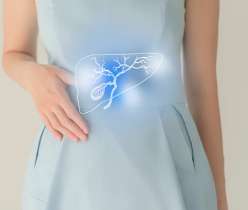Liver cirrhosis is one of the serious liver problems where the liver carries a large amount of scar (fibrosis tissue). Scar tissue originates from ongoing injury to the liver, usually from a chronic viral infection, including hepatitis B and hepatitis C. It can also happen due to excessive alcohol consumption or too much fat in the liver.
The process of scarring is slow, and it usually takes between 20 and 40 years for cirrhosis to develop. The damage can start slowly, often without symptoms of the gradual progression of scarring of the cells, which ultimately results in the loss of liver functions.
Liver cirrhosis has several stages. In the early stages of liver cirrhosis, there are still enough healthy liver cells to perform liver functions. This is often referred to as compensated cirrhosis. However, if the scarring continues, more cells are lost, and the liver can no longer perform its important functions. This is often referred to as decompensated cirrhosis. As the progression of the disease, the liver can become so scarred and shrunken an infected individual can’t survive without a liver transplant. Liver cirrhosis also increases the risk of cancer developing in the liver.
The good news is that cirrhosis of the liver can be diagnosed before the onset of these symptoms through blood tests. The liver disorder is sometimes discovered incidentally during a routine checkup (CT scan of the abdomen) or surgery of the abdomen.
Symptoms of liver problems
The first signs of liver disease include jaundice, belly pain, swelling, itchy skin, pale stool, nausea, vomiting, dark urine, and constant tiredness. You notice liver problem symptoms when your liver function begins to decline. This usually occurs in the later stages of liver problems. A decline in liver function releases or delivers no bile to your small intestine. Instead, bile starts to leak into your blood. This causes symptoms such as light-coloured poop, jaundice, dark-colored pee, weight loss, muscle loss, musty-smelling breath, digestive difficulties, and mild brain impairment. As liver disease advances, You may see liver issues and symptoms in your skin and nails.
The chronic liver disorder progresses in four stages, which include:
-
- Hepatitis
- Fibrosis
- Cirrhosis
- Liver failure
Signs of liver failure or fatty liver symptoms include dark urine, itchy skin, swelling of the legs and ankles, pale stool, nausea, belly pain, and jaundice. These signs of liver damage should not be neglected.
Symptoms of cirrhosis
In people with compensated cirrhosis, there are no specific cirrhosis symptoms; some people with this condition experience being lazy and feel easily tired. They may observe poor night sleep, lack of libido, and reduced appetite. In females, periods usually stop. As the condition progresses, the scar tissue decreases the blood flow through the liver, increasing pressure in the veins, which may contribute to bleeding in the gullet and stomach. Specific cirrhosis of the liver symptoms that occur in the later stages of cirrhosis include confusion, weight loss, swelling of legs and abdomen, bleeding into the bowel, and jaundice.
Causes of liver cirrhosis
Cirrhosis is the end stage of many types of liver disorders, the most common being chronic hepatitis due to either hepatitis B or C virus, fatty liver disease (alcoholic and non-alcoholic fatty liver disease), and alcohol abuse. Non-alcoholic fatty liver disease symptoms include itchy skin/eyes and swelling in the legs/ankles/feet or tummy. Cirrhosis may also be caused by certain conditions that damage the liver. These conditions include autoimmune hepatitis, primary sclerosing cholangitis, and primary biliary cirrhosis. Rarely, cirrhosis may be caused by long-term exposure to certain medications and environmental wastes.
Knowing the cause of your cirrhosis is the initial step in liver care because the different causes of cirrhosis require different kinds of treatment.
Caring for your liver for a longer duration
The liver can repair itself and regrow after it has been damaged. Once the cause has been diagnosed and, in some cases, cured, a liver-friendly diet can support the health of the liver cells, slowing and possibly even reversing the spread of cirrhosis in the liver, ultimately reversing the signs of liver problems. It is important to maintain this lifestyle even if man/woman liver failure symptoms have disappeared to protect against any progression to decompensated cirrhosis.
The bottom line
Cirrhosis treatment and prevention should be best done under the guidance of a healthcare professional. Liver cirrhosis is related to many systemic complications that can lead to death; therefore, cirrhosis treatment is mandatory. A liver transplant is the only option in cause of liver damage. Discuss a new treatment for cirrhosis with your healthcare specialist.




